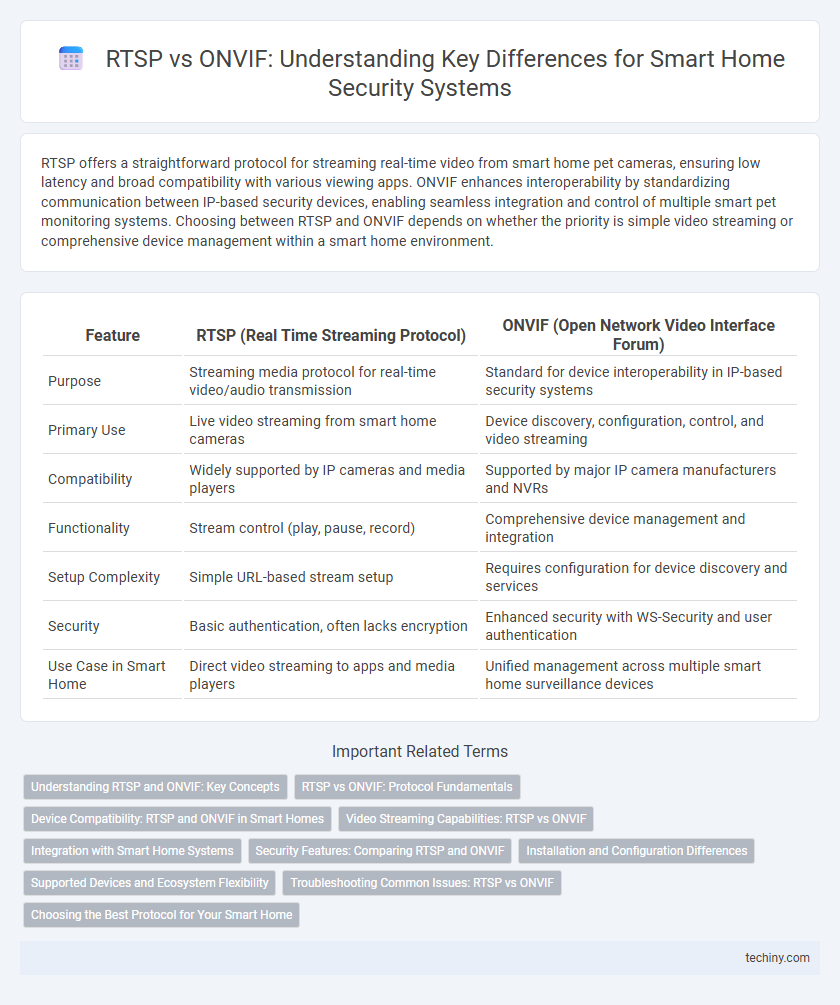RTSP offers a straightforward protocol for streaming real-time video from smart home pet cameras, ensuring low latency and broad compatibility with various viewing apps. ONVIF enhances interoperability by standardizing communication between IP-based security devices, enabling seamless integration and control of multiple smart pet monitoring systems. Choosing between RTSP and ONVIF depends on whether the priority is simple video streaming or comprehensive device management within a smart home environment.
Table of Comparison
| Feature | RTSP (Real Time Streaming Protocol) | ONVIF (Open Network Video Interface Forum) |
|---|---|---|
| Purpose | Streaming media protocol for real-time video/audio transmission | Standard for device interoperability in IP-based security systems |
| Primary Use | Live video streaming from smart home cameras | Device discovery, configuration, control, and video streaming |
| Compatibility | Widely supported by IP cameras and media players | Supported by major IP camera manufacturers and NVRs |
| Functionality | Stream control (play, pause, record) | Comprehensive device management and integration |
| Setup Complexity | Simple URL-based stream setup | Requires configuration for device discovery and services |
| Security | Basic authentication, often lacks encryption | Enhanced security with WS-Security and user authentication |
| Use Case in Smart Home | Direct video streaming to apps and media players | Unified management across multiple smart home surveillance devices |
Understanding RTSP and ONVIF: Key Concepts
RTSP (Real-Time Streaming Protocol) enables direct streaming of video and audio from IP cameras, facilitating real-time monitoring in smart home security systems. ONVIF (Open Network Video Interface Forum) provides a standardized communication protocol to ensure interoperability between different smart home devices and IP cameras regardless of manufacturer. Understanding RTSP's role in streaming and ONVIF's function in device compatibility is crucial for designing efficient and flexible smart home surveillance solutions.
RTSP vs ONVIF: Protocol Fundamentals
RTSP (Real-Time Streaming Protocol) is designed primarily for establishing and controlling media streaming sessions, enabling direct video feed access from IP cameras within smart home systems. ONVIF (Open Network Video Interface Forum) provides a standardized communication framework that supports device discovery, configuration, and interoperability across smart home security devices, extending beyond streaming to include control and event management. RTSP focuses on efficient video transmission protocols, while ONVIF ensures unified device integration and management in smart home surveillance ecosystems.
Device Compatibility: RTSP and ONVIF in Smart Homes
RTSP (Real-Time Streaming Protocol) enables smart home devices to stream video efficiently but often requires manual configuration for compatibility across different brands. ONVIF (Open Network Video Interface Forum) offers standardized interoperability, ensuring seamless communication and device compatibility among diverse smart home security cameras and systems. Integrating ONVIF-compliant devices simplifies network management and enhances scalability in smart home surveillance setups.
Video Streaming Capabilities: RTSP vs ONVIF
RTSP (Real Time Streaming Protocol) excels in delivering low-latency, real-time video streaming by directly managing media transport between IP cameras and clients. ONVIF (Open Network Video Interface Forum) enhances interoperability and device discovery but relies on RTSP or other protocols like HTTP for actual video streaming. Video streaming capabilities are more robust with RTSP for continuous, live feeds, whereas ONVIF offers standardized control and configuration across devices but delegates streaming to protocols such as RTSP.
Integration with Smart Home Systems
RTSP (Real-Time Streaming Protocol) enables direct video stream access from IP cameras, offering broad compatibility but requiring manual configuration for smart home integration. ONVIF (Open Network Video Interface Forum) provides a standardized communication protocol ensuring seamless interoperability among diverse security devices and smart home systems. Smart home platforms commonly prefer ONVIF for its plug-and-play capabilities, enhancing device discovery, control, and automation within integrated home security networks.
Security Features: Comparing RTSP and ONVIF
ONVIF supports robust security features including user authentication, encrypted communication via HTTPS, and device access control, enhancing overall smart home protection. RTSP primarily focuses on streaming protocols with limited native security, often requiring supplementary encryption methods like SSL/TLS for secure transmission. Integrating ONVIF in smart home systems ensures standardized security compliance and interoperability, whereas RTSP alone may pose vulnerabilities without additional security layers.
Installation and Configuration Differences
RTSP (Real-Time Streaming Protocol) typically requires manual configuration through IP addresses and port settings, making installation straightforward but less standardized across devices. ONVIF (Open Network Video Interface Forum) supports plug-and-play functionality with automatic device discovery and configuration, significantly simplifying setup for smart home security cameras. While RTSP is widely compatible, ONVIF's standardized protocol enhances interoperability and reduces configuration time in smart home environments.
Supported Devices and Ecosystem Flexibility
RTSP supports a wide range of IP cameras and streaming devices, providing broad compatibility for various manufacturers and models. ONVIF's standardized protocol enhances ecosystem flexibility by enabling seamless integration and interoperability among security and smart home devices from different vendors. Selecting ONVIF-compliant devices ensures easier scalability and unified control within smart home networks, while RTSP excels in raw video streaming compatibility.
Troubleshooting Common Issues: RTSP vs ONVIF
Troubleshooting common issues in smart home security systems often involves understanding the differences between RTSP and ONVIF protocols. RTSP (Real-Time Streaming Protocol) problems usually stem from incompatible codecs or network firewall restrictions, causing video stream interruptions or latency. ONVIF (Open Network Video Interface Forum) issues frequently arise from device discovery failures or profile mismatches, requiring firmware updates or configuration adjustments to restore seamless interoperability across IP cameras and management software.
Choosing the Best Protocol for Your Smart Home
RTSP (Real-Time Streaming Protocol) offers direct video streaming ideal for real-time surveillance with low latency, while ONVIF (Open Network Video Interface Forum) ensures device interoperability and standardized communication across multiple smart home security cameras. Selecting the best protocol depends on your smart home setup's interoperability needs and whether you prioritize seamless integration (ONVIF) or straightforward, efficient video streaming (RTSP). For comprehensive smart home security systems, ONVIF's standardization supports multi-brand compatibility, whereas RTSP suits scenarios demanding high-quality, real-time video feeds.
RTSP vs ONVIF Infographic

 techiny.com
techiny.com